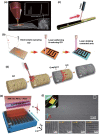Laser Synthesis and Microfabrication of Micro/Nanostructured Materials Toward Energy Conversion and Storage
- PMID: 34138243
- PMCID: PMC8187667
- DOI: 10.1007/s40820-020-00577-0
Laser Synthesis and Microfabrication of Micro/Nanostructured Materials Toward Energy Conversion and Storage
Abstract
Nanomaterials are known to exhibit a number of interesting physical and chemical properties for various applications, including energy conversion and storage, nanoscale electronics, sensors and actuators, photonics devices and even for biomedical purposes. In the past decade, laser as a synthetic technique and laser as a microfabrication technique facilitated nanomaterial preparation and nanostructure construction, including the laser processing-induced carbon and non-carbon nanomaterials, hierarchical structure construction, patterning, heteroatom doping, sputtering etching, and so on. The laser-induced nanomaterials and nanostructures have extended broad applications in electronic devices, such as light-thermal conversion, batteries, supercapacitors, sensor devices, actuators and electrocatalytic electrodes. Here, the recent developments in the laser synthesis of carbon-based and non-carbon-based nanomaterials are comprehensively summarized. An extensive overview on laser-enabled electronic devices for various applications is depicted. With the rapid progress made in the research on nanomaterial preparation through laser synthesis and laser microfabrication technologies, laser synthesis and microfabrication toward energy conversion and storage will undergo fast development.
Keywords: Energy conversion and storage; Laser microfabrication; Laser synthesis; Micro/nanostructured materials.
Figures


















References
-
- Wang H, Tran D, Qian J, Ding F, Losic D. MoS2/graphene composites as promising materials for energy storage and conversion applications. Adv. Mater. Interface. 2019;6(20):1900915. doi: 10.1002/admi.201900915. - DOI
-
- Kim TS, Lee Y, Xu W, Kim YH, Kim M, et al. Direct-printed nanoscale metal-oxide-wire electronics. Nano Energy. 2019;58:437–446. doi: 10.1016/j.nanoen.2019.01.052. - DOI
-
- Dong W, Liu H, Behera JK, Lu L, Ng RJH, et al. Wide bandgap phase change material tuned visible photonics. Adv. Funct. Mater. 2019;29(6):1806181. doi: 10.1002/adfm.201806181. - DOI
Publication types
LinkOut - more resources
Full Text Sources
Miscellaneous
